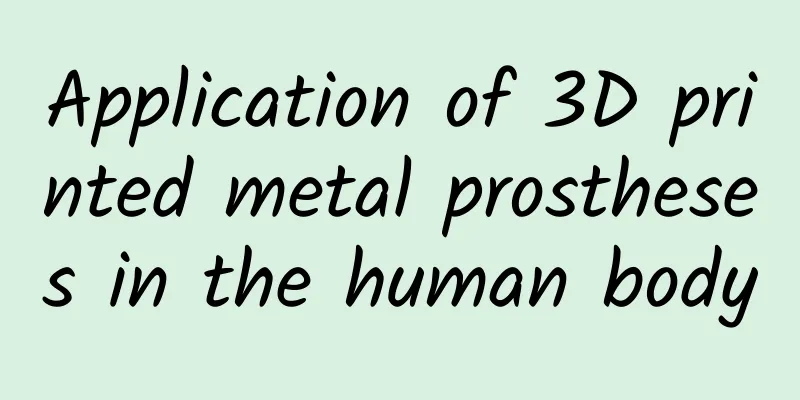Application of 3D printed metal prostheses in the human body

|
Author: Ying Pu, deputy chief physician of Changshu Affiliated Hospital of Nanjing University of Chinese Medicine Reviewer: Wang Weijun, Chief Physician, Drum Tower Hospital Affiliated to Nanjing University Medical School The application of 3D printed metal prostheses in the human body is currently in a rapid development stage. Its high degree of customization and precision greatly meet the needs of personalized medicine. This technology is widely used in the fields of orthopedics and dentistry, such as metal prostheses such as hip joints, knee joints and dental implants [1-2]. 3D printing technology can better match the patient's anatomical structure, thereby improving the functionality and durability of the implant. Figure 1 Copyright image, no permission to reprint 1. Current situation 1. Personalized medicine 3D printing technology allows for the design and production of tailor-made prostheses that precisely match the patient’s specific anatomy, thereby increasing surgical success rates and patient satisfaction. 2. Manufacturing of complex structures 3D printing can produce complex geometric structures that are difficult to achieve with traditional manufacturing methods, which not only improves the physical properties of the prosthesis but also enhances its biocompatibility. Figure 2 Copyright image, no permission to reprint 3. Material Diversity Commonly used metal materials include titanium alloy, stainless steel and cobalt-chromium alloy, which perform well in strength, corrosion resistance and biocompatibility. Figure 3 Copyright image, no permission to reprint 2. Future Development Direction 1. Personalization (1) Customized design: 3D printing technology can create a precisely matched prosthesis based on the patient's specific anatomical data (such as CT or MRI examination results), which not only improves the fit of the prosthesis but also shortens the postoperative recovery time. (2) On-demand manufacturing: Avoid inventory management and waste problems in traditional manufacturing and achieve on-demand production. This is particularly beneficial for prostheses that require special sizes or shapes, and can quickly respond to patient needs. (3) Personalized appearance: Incorporating aesthetic elements based on the patient’s personal preferences into the design increases the patient’s acceptance and satisfaction with the prosthesis. 2. Functionalization (1) Porous structure: By designing porous and gradient materials, the integration of bone tissue and prosthesis can be promoted, biocompatibility can be enhanced, and the healing process can be accelerated. (2) Drug loading function: Drugs are implanted into the prosthesis so that it releases antibiotics or other therapeutic drugs after surgery to reduce the risk of infection and promote recovery [3]. (3) Material innovation: Through the development of new alloys or composite materials, better strength, toughness and biocompatibility can be provided to meet the functional requirements of prostheses in different parts of the body. 3. Intelligent (1) Embedded sensors: Sensors are integrated into the prosthesis to monitor biological parameters such as stress, temperature, and position changes. These data can be used for postoperative monitoring and evaluation of the functional status of the prosthesis [4]. (2) Feedback and adjustment function: Smart prostheses can adjust themselves based on real-time monitoring data to adapt to the patient's activity status and environmental changes and provide dynamic support. (3) Data integration: Integrating prosthesis data with the medical system can help doctors better formulate treatment plans, thereby improving the overall quality of medical care. These development directions not only promote the advancement of 3D printing technology in the medical field, but also open a new chapter in personalized medicine and precision medicine, transforming prostheses from static substitutes into intelligent devices that can dynamically adapt to the needs of the human body. References: Rodriguez Colon R, Nayak VV, Parente PEL, Leucht P, Tovar N, Lin CC, Rezzadeh K, Hacquebord JH, Coelho PG, Witek L. The presence of 3D printing in orthopedics: A clinical and material review. J Orthop Res. 2023, 41(3): 601-613. doi: 10.1002/jor.25388. Pradíes G, Morón-Conejo B, Martínez-Rus F, Salido MP, Berrendero S. Current applications of 3D printing in dental implantology: A scoping review mapping the evidence. Clin Oral Implants Res. 2024, 35(8): 1011-1032. doi: 10.1111/clr.14198. Anushikaa R, Ganesh SS, Victoria VSS, Shanmugavadivu A, Lavanya K, Lekhavadhani S, Selvamurugan N. 3D-printed titanium scaffolds loaded with gelatin hydrogel containing strontium-doped silver nanoparticles promote osteoblast differentiation and antibacterial activity for bone tissue engineering. Biotechnol J. 2024, 19(8): e2400288. doi: 10.1002/biot.202400288. Zhou H, Tawk C, Alici G. A 3D Printed Soft Robotic Hand With Embedded Soft Sensors for Direct Transition Between Hand Gestures and Improved Grasping Quality and Diversity. IEEE Trans Neural Syst Rehabil Eng. 2022, 30: 550-558. doi: 10.1109/TNSRE.2022.3156116. |
<<: Tips for low-salt diet, making it delicious and healthy
Recommend
What are the methods to regulate kidney yang deficiency in women?
Women's unique physiological mechanisms cause...
Does hydrocephalus mean water in the brain?
Hydrocephalus refers to a state of excessive accu...
What are the harms of injecting hyaluronic acid into the nose
The nose is a very important organ on our face. S...
Black blood after medication
Medical abortion is a method that many people lik...
Treatment of pharyngitis during lactation
During the breastfeeding period, pharyngitis may ...
Is cervical erosion contagious? Three major causes are at work
Experts point out that cervical erosion in women ...
Leucorrhea is stringy two or three days before menstruation
Secretions can reflect a woman's physical con...
What causes motion sickness? What to eat when you get motion sickness? Tips to prevent motion sickness
Nowadays, cars are almost indispensable for trave...
What does white tape mold mean?
Yeast infections are more common in women. When a...
Symptoms of fetal arrest at 19 weeks of pregnancy
Being pregnant is a very happy thing. Thinking ab...
What to do if the cervix is loose during pregnancy
Never underestimate the problem of cervical relax...
Which is better, the TV series or the novel "Joy of Life"? Why can't I buy the book "Joy of Life"?
The TV series "Joy of Life" is adapted ...
Why does a woman feel weak, tired and sleepy all over?
As the pressure of life and work continues to inc...
LinkedIn Financial Report: LinkedIn's revenue in Q2 2012 was $228.2 million, up 89% year-on-year
On the morning of August 3, 2012, LinkedIn, an Am...









